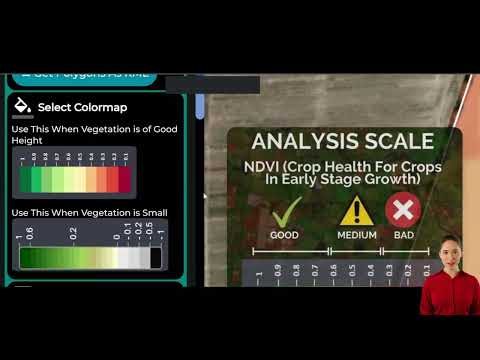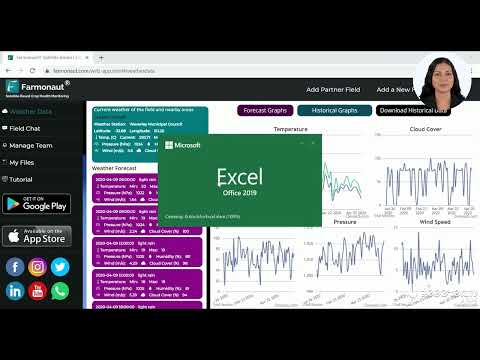Southern California Braces for Severe Storm: Flash Flood Warnings and Evacuation Orders Issued
As we at Farmonaut closely monitor the unfolding weather crisis in Southern California, we’re reminded of the critical importance of advanced warning systems and data-driven decision-making in agriculture and environmental management. Our satellite-based monitoring technologies provide crucial insights for farmers and authorities alike in times of severe weather events.
Heavy rain is falling across a large swath of Southern California this afternoon as the region braces for intense bouts of precipitation that have already begun to flood roads and threaten to unleash debris flows in areas recently burned by wildfires. The situation is rapidly evolving, and we’re here to provide a comprehensive overview of the critical nature of this ongoing weather emergency.
“Recent wildfires in Southern California have left over 100,000 acres vulnerable to severe flooding and mudslides during the current storm.”
Flash Flood Warnings and Immediate Threats
The National Weather Service has issued flash flood warnings for several key areas in Southern California, including:
- Malibu
- Pacific Palisades
- Altadena
- Much of Los Angeles County, affecting approximately 7 million people
These warnings indicate that flooding has either begun or is imminent in these areas. The threat is particularly severe in regions recently affected by wildfires, where the soil can repel water and allow sheets of mud to race downhill, collecting debris along the way.
Dr. Ariel Cohen, the meteorologist in charge of the National Weather Service office overseeing the Los Angeles region, warns, “If heavy precipitation falls over the burn scars, there will be the potential for very severe debris flows to occur in addition to mudslides and rock slides. Everyone needs to be at a high state of readiness.”
Evacuation Orders and Community Impact
The severity of the situation has prompted authorities to issue evacuation orders across multiple counties:
- Los Angeles County: More than 100 homes are under mandatory evacuation orders in the city of Los Angeles, particularly in areas affected by the recent Palisades fire.
- Sierra Madre: Residents were told to evacuate before the worst of the storm hit.
- Altadena: Water is gushing downhill, carrying charred debris from recent fires.
- Orange County: The Sheriff’s Department has issued an evacuation warning for the area near the site of the Airport fire.
- San Bernardino County: An evacuation order has been issued, citing the potential for mud and debris flow.
Sheriff Robert Luna of Los Angeles County emphasized the importance of heeding evacuation orders: “Storms can bring sudden and severe conditions that make staying back home extremely risky. Do not take that chance.”
Impact on Infrastructure and Transportation
The severe weather is already causing significant disruptions to transportation and infrastructure:
“The Pacific Coast Highway, stretching 656 miles along California’s coast, faces partial closure due to muddy water from the storm.”
- Pacific Coast Highway: Muddy water cascading across parts of the highway has prompted officials to shut the roadway until at least tomorrow morning.
- Sierra Nevada: Heavy snow has forced the closure of Interstate 80 due to low visibility and vehicles spinning out on icy road surfaces.
These closures highlight the widespread impact of the storm system across various regions and elevations in California.
Preparedness and Emergency Response
State and local authorities are mobilizing resources to respond to the emergency:
- The California governor’s office of emergency services has positioned resources across 14 counties, from Sonoma County in Northern California to San Diego County at the southern border.
- In Santa Barbara County, which experienced a deadly mudslide in 2018, officials have been preparing for the storm since late last week.
- San Luis Obispo County is preparing for possible flooding as severe as what occurred in January 2023, when heavy rainfall inundated communities.
At Farmonaut, we understand the critical role that accurate, real-time data plays in disaster preparedness and response. Our satellite-based monitoring systems can provide valuable insights into soil moisture levels, vegetation health, and potential flood risks, helping authorities and farmers make informed decisions in the face of severe weather events.
The Science Behind the Storm
To better understand the severity of this weather event, it’s important to delve into the meteorological factors at play:
- Atmospheric Rivers: The current storm system is fueled by what meteorologists call an “atmospheric river” – a narrow corridor of concentrated moisture in the atmosphere that can deliver intense rainfall.
- Burn Scar Vulnerability: Areas recently affected by wildfires are particularly susceptible to flash flooding and debris flows. The intense heat from fires can create a water-repellent layer on the soil, leading to rapid runoff during heavy rainfall.
- Topographical Factors: Southern California’s varied terrain, with steep hillsides and canyons, can exacerbate the risk of flash floods and mudslides by channeling water and debris into concentrated flows.
Our Farmonaut technologies, including our satellite-based crop health monitoring and AI-driven advisory systems, can help farmers and land managers assess these risks and plan accordingly, even in non-emergency situations.
Impact on Agriculture and Land Management
While the immediate focus is on public safety, the severe weather also has significant implications for agriculture and land management in the affected regions:
- Soil Erosion: Heavy rainfall can lead to significant soil erosion, particularly in areas already compromised by wildfires. This can have long-term impacts on soil health and agricultural productivity.
- Crop Damage: Flooding and debris flows can cause direct damage to crops, potentially leading to significant economic losses for farmers.
- Water Management: While the rainfall might provide some relief to drought-stricken areas, the intensity of the precipitation poses challenges for water management systems.
At Farmonaut, we offer tools that can help farmers and land managers navigate these challenges. Our satellite-based monitoring systems provide real-time data on soil moisture levels and crop health, enabling more informed decision-making in the face of extreme weather events.
Long-Term Implications and Climate Resilience
As we witness the impacts of this severe storm, it’s crucial to consider the broader implications for climate resilience in Southern California and beyond:
- Infrastructure Resilience: The storm highlights the need for more robust infrastructure capable of withstanding extreme weather events, particularly in areas prone to wildfires and subsequent flooding.
- Land Use Planning: There may be a need to reassess land use policies in high-risk areas, balancing development needs with public safety concerns.
- Agricultural Adaptation: Farmers in the region may need to adapt their practices to account for the increasing frequency and intensity of extreme weather events.
Farmonaut’s technologies can play a crucial role in building climate resilience in the agricultural sector. Our AI-driven advisory system, Jeevn AI, provides personalized recommendations to help farmers adapt to changing weather patterns and optimize their resource use.
Community Response and Support
In times of crisis, community support and solidarity are crucial. Here are some ways communities are coming together to face this challenge:
- Volunteer Efforts: Many local organizations are mobilizing volunteers to help with sandbagging efforts and assist vulnerable community members.
- Information Sharing: Community networks are playing a vital role in disseminating important information and updates about the storm and evacuation orders.
- Shelter Support: Local schools and community centers are opening their doors to provide temporary shelter for evacuees.
At Farmonaut, we believe in the power of community and information sharing. Our platform allows farmers to connect and share insights, fostering a collaborative approach to agricultural challenges.
Storm Impact Overview
| Region | Hazard Type | Risk Level | Evacuation Status |
|---|---|---|---|
| Los Angeles County | Flash floods, Mudslides | Extreme | Mandatory Evacuation Orders |
| Santa Barbara County | Debris Flows | High | Evacuation Warnings |
| San Luis Obispo | Flooding | High | Evacuation Warnings |
| Malibu | Flash Floods | Extreme | Mandatory Evacuation Orders |
| Sierra Nevada | Heavy Snow, Icy Roads | High | Road Closures |
How Farmonaut Can Help
In challenging times like these, access to accurate, real-time data is crucial for both farmers and emergency responders. Farmonaut’s suite of tools can provide valuable support in several ways:
- Satellite-Based Crop Health Monitoring: Our technology can help assess the impact of severe weather on crops, allowing for rapid response and recovery planning.
- AI-Driven Advisory System: Jeevn AI can provide personalized recommendations to help farmers prepare for and recover from extreme weather events.
- Resource Management Tools: Our platform can assist in optimizing water usage and other resources in the aftermath of severe storms.
- Carbon Footprinting: As we face more frequent extreme weather events, understanding and reducing agricultural carbon footprints becomes increasingly important.
To learn more about how Farmonaut can support your agricultural operations, visit our web app or download our mobile apps:
FAQ Section
Q: How can I stay updated on the latest storm developments?
A: Follow local news outlets, official social media accounts of emergency services, and download weather alert apps for real-time updates.
Q: What should I include in an emergency kit?
A: Your emergency kit should include water, non-perishable food, flashlights, batteries, first-aid supplies, important documents, and any necessary medications.
Q: How can farmers prepare for potential flooding?
A: Farmers should move livestock and equipment to higher ground, secure loose items, and have a plan for water drainage. Farmonaut’s satellite monitoring can help identify vulnerable areas on your farm.
Q: What should I do if I’m ordered to evacuate?
A: Follow evacuation orders immediately. Have a predetermined evacuation route and destination. Take your emergency kit and important documents with you.
Q: How can Farmonaut help in post-storm recovery?
A: Our satellite imagery and AI analysis can help assess crop damage, soil erosion, and flooding extent, aiding in recovery planning and insurance claims.
Conclusion
As Southern California faces this severe weather event, our thoughts are with all those affected. We urge everyone in the impacted areas to stay informed, follow the guidance of local authorities, and prioritize safety above all else.
At Farmonaut, we remain committed to supporting the agricultural community through advanced technology and data-driven insights. While we can’t control the weather, we can work together to build more resilient and sustainable farming practices that can better withstand these challenges.
Stay safe, stay informed, and remember that communities are strongest when they come together in times of crisis.
For more information on how Farmonaut can support your agricultural operations, visit our web app or explore our API for developers.
Earn With Farmonaut: Earn 20% recurring commission with Farmonaut’s affiliate program by sharing your promo code and helping farmers save 10%. Onboard 10 Elite farmers monthly to earn a minimum of $148,000 annually—start now and grow your income!






